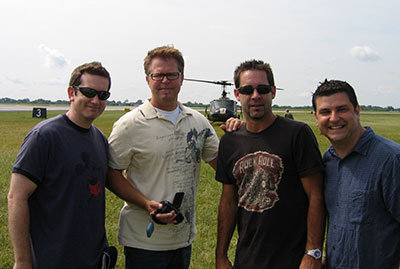

Miami alumnus soars with animation career
Disney's newest film, "Planes," takes flight

Paul Gerard (right) at the 2009 Dayton Air Show with Jeffrey Howard, screenwriter, "Planes"; Klay Hall, director, "Planes"; and Michael Karafilis, vice president of creative development, DisneyToon Studios.
The immersive 3-D world of computer-animated films wasn't yet on Paul Gerard's radar when he was pursuing a business degree at Miami University.
"I actually was going to get into banking. I had a very circuitous route from Miami University to Hollywood," said Gerard (Miami '89), director of creative development at DisneyToon Studios since 2008.
He has been busy promoting Walt Disney Pictures' latest release, "Planes," which lands in theaters Friday, Aug. 9.
A spinoff of Pixar's "Cars" franchise, "Planes" tells the story of Dusty Crophopper, a crop duster who dreams of competing in an around-the-world air race although he's not built for racing and is afraid of heights.

Paul Gerard
As creative development director, Gerard plays a key role in developing stories for films that will come to life on the silver screen.
On this project he worked with "Planes" director Klay Hall and screenwriter Jeffrey Howard after they met with executive producer John Lasseter, who had directed "Cars" and "Cars 2." Lasseter instantly became a major blip on Gerard's radar screen in 1995 with "Toy Story," the first entirely computer-animated feature film.
"Since the moment I saw 'Toy Story,' I've been a huge fan of John Lasseter's work, so to actually get to work for him, it's like a dream come true."
"Planes" and a return flight to Ohio
Early research for "Planes" brought Gerard and others on the creative team to Ohio in July 2009. They visited the National Museum of the U.S. Air Force at Wright-Patterson Air Force Base and the Dayton Air Show. They watched the Air Force Thunderbirds zoom above spectators and gained an up-close look at a rare, 1950s aero car designed to drive and fly.
At the museum they saw the Memphis Belle undergoing restoration and studied several other planes, including a Vought F4U Corsair fighter aircraft.
One of the film's main characters, Skipper Riley, is a Corsair, while Franz Fliegenhosen is an aero car that transforms into a plane.
Gerard said conducting extensive research on airports, runways and other details is essential, especially with an animated film, so the magic can happen when the lights go down.
"We have hundreds of artists and talented people who have to draw absolutely everything," he said.
Gerard recalled driving across Minnesota to photograph the sky and landscape so they could nail the opening scene set in fictional Propwash Junction.
Leading a nationally ranked team at Miami
The 2009 trip to southwest Ohio was Gerard's first since graduating 20 years earlier from Miami, where he majored in finance and minored in business information systems.
He grew up in a small town in Illinois but chose Miami over the closer-to-home University of Illinois because of the finance program.
Gerard was on Miami's speech and debate team, which finished third in the nation his senior year when he was president.
After graduation he moved to Chicago, where by day he spent the next eight years working in banking and software design.
At night he ditched his business attire for his fun job at a small theater company he started with friends he had met during speech competitions.
It was in Chicago that he crossed paths with a friend who was attending the University of Southern California's School of Cinema-Television. He told him about the Peter Stark Program for film producers – something that piqued Gerard's interest because, by then, he had already become involved in films.
"I got to a point where I had been doing enough shows that I wanted to expand. I worked on a couple of independent films in Chicago and realized … that I was more apt to produce films than to work at a bank," he said.
In 1997 Gerard moved to California and enrolled in Stark’s program, earning a master of fine arts two years later. Halfway through the program, 20th Century Fox had recruited him to work in its story department.
He spent about five years there helping to develop such live-action features as "X-Men," "Alien vs. Predator" and "Big Momma's House." But soon he would discover the world of animation.
Reaching an audience "from 8 to 80"
Gerard's entry into the world of animation came in 2002 when he was hired as director of development for Sony Pictures' new animation division.
"When I started there, there were about six employees; now there are 180 or 190," he said.
At Sony he was involved in the development of "Open Season," "Surf's Up," "Cloudy with a Chance of Meatballs" and "Hotel Transylvania."
Though Gerard said he enjoyed developing live-action films, he feels most at home working in animation. He gets to make movies that reach a broad audience — from his 7-year-old son to the real-life crop duster he sat next to at a recent "Planes" screening for about 15,000 aviators in Oshkosh, Wis.
"What I like about animation so much is that you can make a movie that can appeal to everyone —from the boardroom to the playground," he said. "You can actually reach an audience from 8 to 80. I couldn’t see anything else that would be like that, other than animation."
Written by Margo Kissell, University News and Communications, kisselm@MiamiOh.edu
